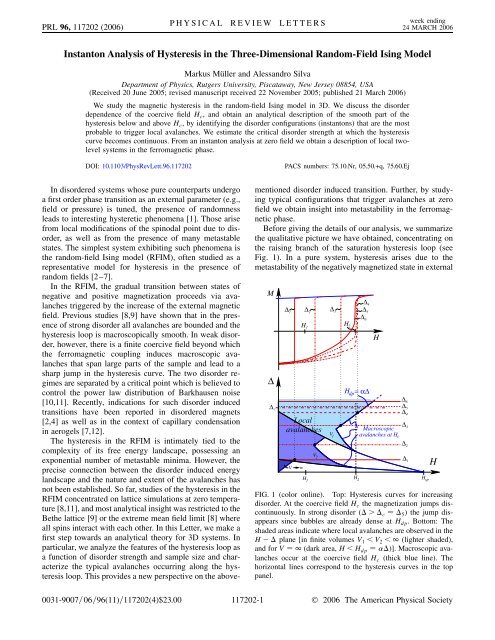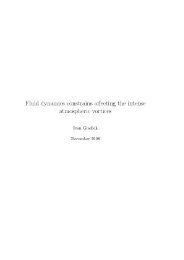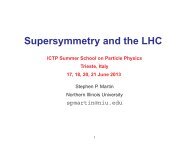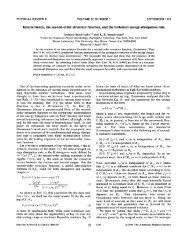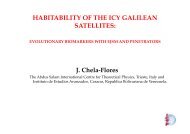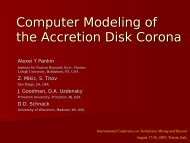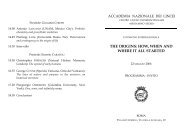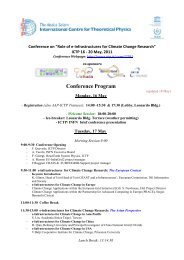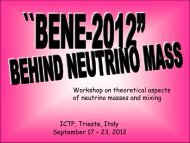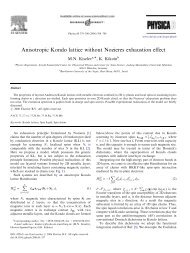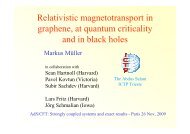Phys. Rev. Lett 96, 117202 - ICTP
Phys. Rev. Lett 96, 117202 - ICTP
Phys. Rev. Lett 96, 117202 - ICTP
Create successful ePaper yourself
Turn your PDF publications into a flip-book with our unique Google optimized e-Paper software.
PRL <strong>96</strong>, <strong>117202</strong> (2006)<br />
PHYSICAL REVIEW LETTERS week ending<br />
24 MARCH 2006<br />
Instanton Analysis of Hysteresis in the Three-Dimensional Random-Field Ising Model<br />
Markus Müller and Alessandro Silva<br />
Department of <strong>Phys</strong>ics, Rutgers University, Piscataway, New Jersey 08854, USA<br />
(Received 20 June 2005; revised manuscript received 22 November 2005; published 21 March 2006)<br />
We study the magnetic hysteresis in the random-field Ising model in 3D. We discuss the disorder<br />
dependence of the coercive field H c , and obtain an analytical description of the smooth part of the<br />
hysteresis below and above H c , by identifying the disorder configurations (instantons) that are the most<br />
probable to trigger local avalanches. We estimate the critical disorder strength at which the hysteresis<br />
curve becomes continuous. From an instanton analysis at zero field we obtain a description of local twolevel<br />
systems in the ferromagnetic phase.<br />
DOI: 10.1103/<strong>Phys</strong><strong>Rev</strong><strong>Lett</strong>.<strong>96</strong>.<strong>117202</strong><br />
PACS numbers: 75.10.Nr, 05.50.+q, 75.60.Ej<br />
In disordered systems whose pure counterparts undergo<br />
a first order phase transition as an external parameter (e.g.,<br />
field or pressure) is tuned, the presence of randomness<br />
leads to interesting hysteretic phenomena [1]. Those arise<br />
from local modifications of the spinodal point due to disorder,<br />
as well as from the presence of many metastable<br />
states. The simplest system exhibiting such phenomena is<br />
the random-field Ising model (RFIM), often studied as a<br />
representative model for hysteresis in the presence of<br />
random fields [2–7].<br />
In the RFIM, the gradual transition between states of<br />
negative and positive magnetization proceeds via avalanches<br />
triggered by the increase of the external magnetic<br />
field. Previous studies [8,9] have shown that in the presence<br />
of strong disorder all avalanches are bounded and the<br />
hysteresis loop is macroscopically smooth. In weak disorder,<br />
however, there is a finite coercive field beyond which<br />
the ferromagnetic coupling induces macroscopic avalanches<br />
that span large parts of the sample and lead to a<br />
sharp jump in the hysteresis curve. The two disorder regimes<br />
are separated by a critical point which is believed to<br />
control the power law distribution of Barkhausen noise<br />
[10,11]. Recently, indications for such disorder induced<br />
transitions have been reported in disordered magnets<br />
[2,4] as well as in the context of capillary condensation<br />
in aerogels [7,12].<br />
The hysteresis in the RFIM is intimately tied to the<br />
complexity of its free energy landscape, possessing an<br />
exponential number of metastable minima. However, the<br />
precise connection between the disorder induced energy<br />
landscape and the nature and extent of the avalanches has<br />
not been established. So far, studies of the hysteresis in the<br />
RFIM concentrated on lattice simulations at zero temperature<br />
[8,11], and most analytical insight was restricted to the<br />
Bethe lattice [9] or the extreme mean field limit [8] where<br />
all spins interact with each other. In this <strong>Lett</strong>er, we make a<br />
first step towards an analytical theory for 3D systems. In<br />
particular, we analyze the features of the hysteresis loop as<br />
a function of disorder strength and sample size and characterize<br />
the typical avalanches occurring along the hysteresis<br />
loop. This provides a new perspective on the abovementioned<br />
disorder induced transition. Further, by studying<br />
typical configurations that trigger avalanches at zero<br />
field we obtain insight into metastability in the ferromagnetic<br />
phase.<br />
Before giving the details of our analysis, we summarize<br />
the qualitative picture we have obtained, concentrating on<br />
the raising branch of the saturation hysteresis loop (see<br />
Fig. 1). In a pure system, hysteresis arises due to the<br />
metastability of the negatively magnetized state in external<br />
FIG. 1 (color online). Top: Hysteresis curves for increasing<br />
disorder. At the coercive field H c the magnetization jumps discontinuously.<br />
In strong disorder ( > c 5 ) the jump disappears<br />
since bubbles are already dense at H dp . Bottom: The<br />
shaded areas indicate where local avalanches are observed in the<br />
H plane [in finite volumes V 1
PRL <strong>96</strong>, <strong>117202</strong> (2006)<br />
PHYSICAL REVIEW LETTERS week ending<br />
24 MARCH 2006<br />
fields H below the spinodal field H sp . This simple scenario<br />
is strongly modified by disorder: Because of rare regions<br />
with strong positive fields, bubbles of positive magnetization<br />
are created spontaneously at any small H. However,<br />
they are prevented from spreading by disorder induced<br />
pinning. The latter leads to a finite coercive field H c which<br />
grows with disorder strength. For fields below H c , the<br />
magnetization curve is determined by small avalanches,<br />
triggered by the increase of H. AtH c sample spanning<br />
avalanches occur, while beyond H c only small regions with<br />
strong negative random fields may resist the invasion of the<br />
positively magnetized phase, finally collapsing under further<br />
increase of the field. With increasing disorder strength,<br />
the local avalanches become so dense that the emerging<br />
bubbles already percolate before the threshold for unlimited<br />
spread, H c is reached. In this situation, there is no<br />
room for avalanches to spread at H c , and the hysteresis<br />
loop becomes continuous.<br />
In order to study the nature of avalanches in the 3D<br />
RFIM, we have analyzed its continuum version, described<br />
by the standard Landau-Ginzburg free energy<br />
Z 1<br />
F F 0 dx<br />
2 r’ 2 V ’ H’ h x ’ : (1)<br />
Here ’ x is the coarse-grained magnetization whose tendency<br />
towards ferromagnetism is described by the potential<br />
V ’ 2<br />
2<br />
m<br />
’ 2 g<br />
4 ’ 4 with the reduced temperature<br />
m 2 / 1 T=T c . H is the uniform external magnetic<br />
field, and h x is a Gaussian random field with zero<br />
mean and variance hh x h x 0 i x x 0 . The prefactor<br />
F 0 depends on the microscopic details and increases<br />
with the range of ferromagnetic interactions.<br />
We only consider T
PRL <strong>96</strong>, <strong>117202</strong> (2006)<br />
PHYSICAL REVIEW LETTERS week ending<br />
24 MARCH 2006<br />
local minima of the action<br />
S<br />
1<br />
2<br />
Z<br />
drh 2 r<br />
1<br />
2<br />
Z<br />
dr<br />
1<br />
2 r2 V 0 H 2 (4)<br />
within the set of marginal states 2 M. Here, we used<br />
Eq. (2) to express the random field in terms of .<br />
Assuming spherically symmetric instantons, the Euler-<br />
Lagrange equation takes the form<br />
2<br />
d<br />
V 00<br />
d<br />
2<br />
V 0<br />
H<br />
2<br />
d 2<br />
V 00 d 2<br />
2<br />
V 0 H Cn (5)<br />
d 1<br />
d<br />
where @ 2 r r<br />
@ r denotes the radial part of the<br />
Laplacian in d dimensions, C is a Lagrange multiplier,<br />
and n is the local normal to the manifold M.<br />
Performing an extensive search for local minima of S<br />
[analytically by solving (5) and numerically by variational<br />
minimization of (4)] we found two types of optimal<br />
random-field configurations. For H
PRL <strong>96</strong>, <strong>117202</strong> (2006)<br />
∆F<br />
F<br />
L<br />
H<br />
T<br />
{Ψ}<br />
FIG. 3 (color online). Schematic view of the temperature<br />
evolution of the local free energy landscape in a random field<br />
h inst rjH 0 h. Upon cooling, the high temperature state<br />
(H) becomes unfavorable with respect to an emerging low<br />
energy state with more uniform magnetization (L), but remains<br />
metastable in a temperature range T due to a free energy<br />
barrier F.<br />
PHYSICAL REVIEW LETTERS week ending<br />
24 MARCH 2006<br />
∆T<br />
conjectured by Villain in the context of pinned domain<br />
walls [15]. Over a range of order T 3=2 [where<br />
R h<br />
2 1=2 ] the two states coexist, being separated by a free<br />
energy barrier of order F 2 . The spatial density of<br />
such two-level systems with a given free energy barrier<br />
scales as F /exp S 0 O F 1=2 with S 0<br />
S h inst rjH 0 ’ 8:2= . These two-level systems are<br />
very similar to the metastable bubbles observed numerically<br />
above the ferromagnetic transition [20]. We expect a<br />
deeper analysis of the bifurcation of states along the lines<br />
of this <strong>Lett</strong>er to yield new insight into the nature of the<br />
phase transition in the RFIM.<br />
We thank J. Cardy, T. Nattermann, M. Rosinberg,<br />
G. Tarjus, and, in particular, L. B. Ioffe for useful discussions.<br />
We are grateful to A. Rosso for providing us the code<br />
from Ref. [17]. This work was supported by NSF Grant<br />
No. DMR-0210575.<br />
for the transition line in the T plane. It is interesting to<br />
note that for c the depinning field H dp is very<br />
close to the threshold field H 2 for typical avalanches to<br />
overcome surface tension barriers.<br />
Above we used the identity of the coercive field and the<br />
depinning threshold. This applies to the infinite volume<br />
limit, as a result of which one finds H c ! 0 !0 (see,<br />
e.g., Ref. [19]), instead of H c ! 0 !H sp , which holds<br />
for finite size systems (see bottom of Fig. 1), H<br />
p<br />
sp<br />
2=3 3 0:385 being the spinodal field of the pure system.<br />
For a finite system of volume V, the only type of bubbles<br />
occurring in the hysteresis loop are those with sufficiently<br />
large density, V H; * 1. This relation allows us to<br />
estimate the field H at which the first (typical) bubbles<br />
occur. If the disorder is so weak that H >H 2 , there will be<br />
a single sample spanning avalanche around the coercive<br />
field H ’ H sp 0:5 log V= 3 . For stronger disorder<br />
(H


